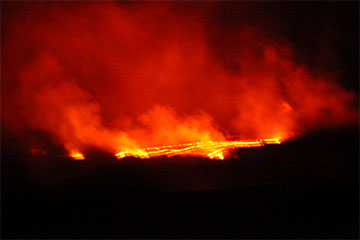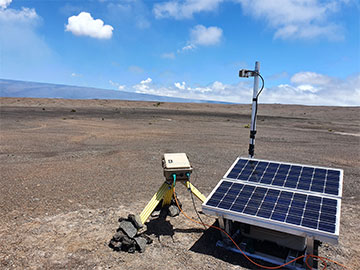
Kīlauea lava showing substantial gas emissions. [Image: T. Pering]
There are about 1,350 potentially active volcanoes on land across the globe, according to the US Geological Survey. Since gas emissions indicate magmatic activities under the surface of a volcano, monitoring of those emissions is important for timely warning to nearby communities.
Now an international group of researchers says it has created a low-cost, low-power camera that can continuously measure volcanic emissions (Front. Earth Sci., doi: 10.3389/feart.2023.1088992). “Our instrument uses a sensor not dissimilar to smartphone camera sensors,” said the study’s lead author Thomas Wilkes, University of Sheffield, UK, in a press release. “It is modified to make it sensitive to ultraviolet light, therefore enabling SO2 detection.”
Building a camera system
SO2 is the most common volcanic gas species detected using remote-sensing devices, thanks to its relatively low atmospheric concentrations and strong absorption bands at ultraviolet and infrared wavelengths. Ultraviolet SO2 cameras have become particularly valuable for measuring volcanic emissions since their development in the mid-2000s because of their high-temporal and high-spatial resolutions.
However, SO2 cameras have not been widely used as continuous-monitoring tools, which could be due to their fairly high price, the researchers write. Scientific-grade UV cameras cost from thousands to tens of thousands of dollars, and building and operating one can cost upwards of US$20,000. In addition, SO2 cameras require users to be present for measurements, making long-term data acquisition difficult.
To tackle these problems, Wilkes and colleagues developed a novel SO2 camera. They used a Raspberry Pi–based camera, first removing a Bayer filter from the device to improve its UV sensitivity. Then, the team created a UV-transmissive optical system and mounted it to the camera. The resulting field of view was 28°×21°.
The team’s SO2 camera collects data using free software called PyCamPermanent and stores them in a 1 TB external solid-state drive with a Raspberry Pi micro-SD card as a backup. The acquired data are then processed using the same software.
Using less power and less money
The camera system’s overall power consumption is relatively low, the researchers write. The instrument uses 0.96 W of power when in a “sleep mode,” 6 W when it’s on and 12 W when it’s acquiring data.
The low power consumption is partly due to the system’s use of a low-power CMOS sensor. The researchers also incorporated a relatively new spectrometer, produced in 2015, that shows much-improved thermal stability. This allowed the scientists to ditch a thermoelectric cooler that they had previously used to control the temperature of a spectrometer, lowering both the amount of power required for and the overall cost of the system.
The total cost of the instrument’s parts is roughly US$5,000, mostly owing to the UV spectrometer that costs around US$3,500. The overall price tag is still considerably lower than those of previous options, the team argues. A big part of the reduction came from choosing a Raspberry Pi–based camera, which costs just hundreds of dollars—one to two orders of magnitude less than the scientific-grade devices. The researchers also avoided extra costs by using 3D-printed parts, open-source software and fewer and smaller solar panels and batteries.
Deploying cameras to volcanoes
The novel SO2 camera system on Kīlauea volcano, HI, USA. The gas plume can be faintly seen rising from the crater at the center of the image and drifting to the left. The flank of Mauna Loa, another volcano in Hawaii, can be seen in the background. [Image: T. Pering] [Enlarge image]
The team’s cameras are now in continuous operation on volcanoes Lascar and Kīlauea, in Northern Chile and Hawaii, USA, respectively. “Before now, only three volcanoes have had permanent SO2 cameras installed on them,” Wilkes said. “[I]t is important to be able to measure volcanic activity continuously, since it can vary substantially from minutes to decades to centuries and beyond,” Wilkes added.
There are some limitations to SO2 cameras, however. “They are dependent on meteorological conditions, and work best under clear blue skies when the volcanic gas plume moves in a 90-degree angle to the viewing direction of the camera,” said Wilkes. The researchers write that their camera’s performance also needs longer-term testing.

